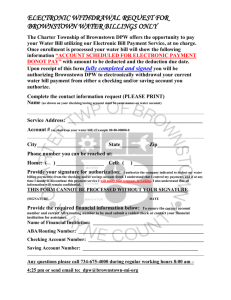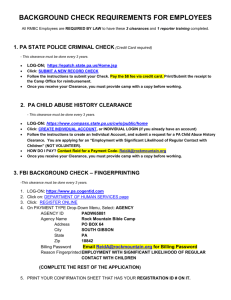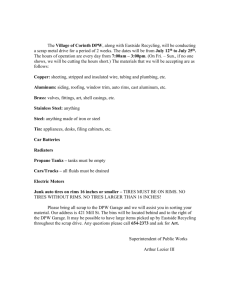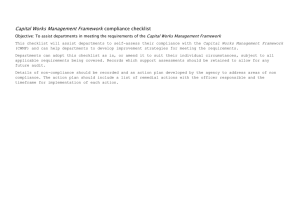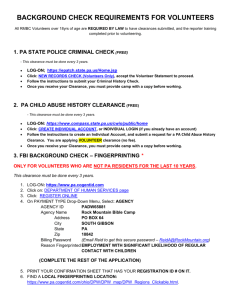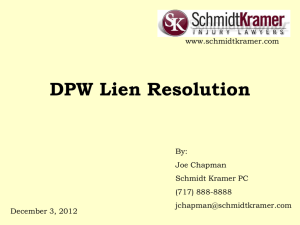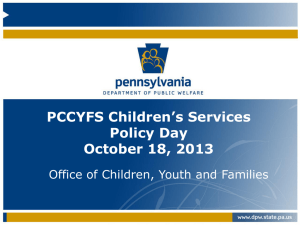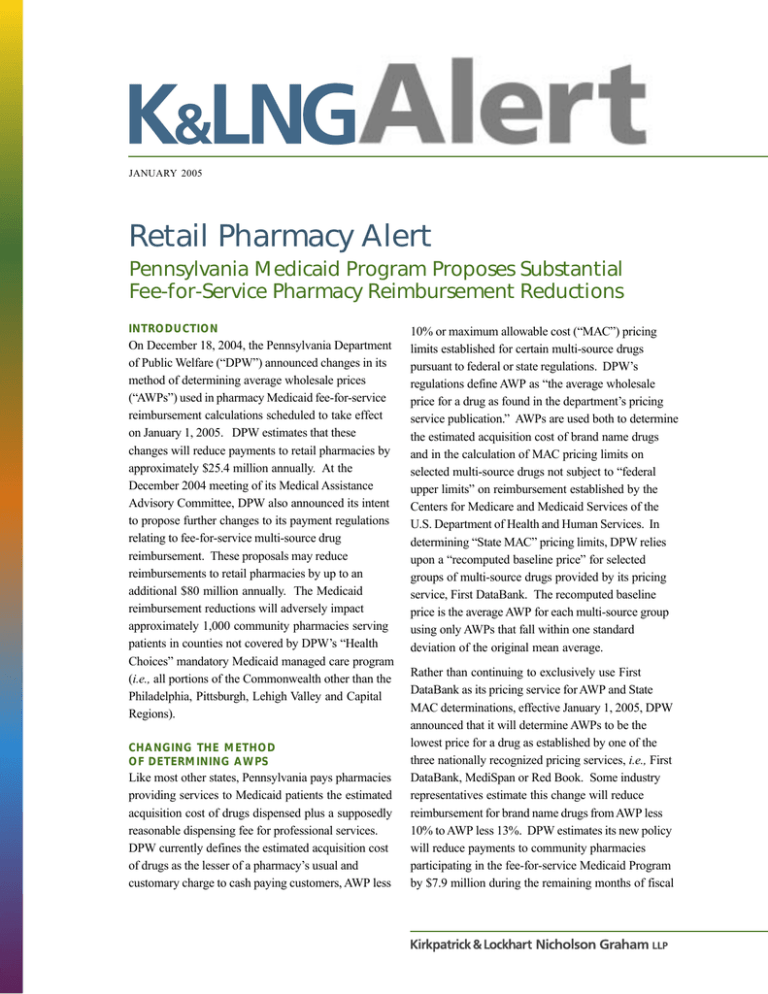
JANUARY 2005
Retail Pharmacy Alert
Pennsylvania Medicaid Program Proposes Substantial
Fee-for-Service Pharmacy Reimbursement Reductions
INTRODUCTION
On December 18, 2004, the Pennsylvania Department
of Public Welfare (“DPW”) announced changes in its
method of determining average wholesale prices
(“AWPs”) used in pharmacy Medicaid fee-for-service
reimbursement calculations scheduled to take effect
on January 1, 2005. DPW estimates that these
changes will reduce payments to retail pharmacies by
approximately $25.4 million annually. At the
December 2004 meeting of its Medical Assistance
Advisory Committee, DPW also announced its intent
to propose further changes to its payment regulations
relating to fee-for-service multi-source drug
reimbursement. These proposals may reduce
reimbursements to retail pharmacies by up to an
additional $80 million annually. The Medicaid
reimbursement reductions will adversely impact
approximately 1,000 community pharmacies serving
patients in counties not covered by DPW’s “Health
Choices” mandatory Medicaid managed care program
(i.e., all portions of the Commonwealth other than the
Philadelphia, Pittsburgh, Lehigh Valley and Capital
Regions).
CHANGING THE METHOD
OF DETERMINING AWPS
Like most other states, Pennsylvania pays pharmacies
providing services to Medicaid patients the estimated
acquisition cost of drugs dispensed plus a supposedly
reasonable dispensing fee for professional services.
DPW currently defines the estimated acquisition cost
of drugs as the lesser of a pharmacy’s usual and
customary charge to cash paying customers, AWP less
10% or maximum allowable cost (“MAC”) pricing
limits established for certain multi-source drugs
pursuant to federal or state regulations. DPW’s
regulations define AWP as “the average wholesale
price for a drug as found in the department’s pricing
service publication.” AWPs are used both to determine
the estimated acquisition cost of brand name drugs
and in the calculation of MAC pricing limits on
selected multi-source drugs not subject to “federal
upper limits” on reimbursement established by the
Centers for Medicare and Medicaid Services of the
U.S. Department of Health and Human Services. In
determining “State MAC” pricing limits, DPW relies
upon a “recomputed baseline price” for selected
groups of multi-source drugs provided by its pricing
service, First DataBank. The recomputed baseline
price is the average AWP for each multi-source group
using only AWPs that fall within one standard
deviation of the original mean average.
Rather than continuing to exclusively use First
DataBank as its pricing service for AWP and State
MAC determinations, effective January 1, 2005, DPW
announced that it will determine AWPs to be the
lowest price for a drug as established by one of the
three nationally recognized pricing services, i.e., First
DataBank, MediSpan or Red Book. Some industry
representatives estimate this change will reduce
reimbursement for brand name drugs from AWP less
10% to AWP less 13%. DPW estimates its new policy
will reduce payments to community pharmacies
participating in the fee-for-service Medicaid Program
by $7.9 million during the remaining months of fiscal
year 2004-2005 and will reduce payments during the
full 2005-2006 fiscal year by $25.4 million.
DPW announced this program modification by the
publication of an announcement in the Pennsylvania
Bulletin on December 18, 2004, and provided a
limited opportunity for parties to submit comments
not later than December 28, 2004. DPW’s decision to
provide only a limited opportunity for review and
comment in the middle of the holiday season and to
by-pass the Commonwealth’s regulatory review
process has generated substantial dissatisfaction
within the retail pharmacy community. Because
existing Pennsylvania regulations define AWP based
upon “the department’s pricing service,” concerns
have been expressed that DPW cannot substitute the
lowest price as established by one of three pricing
services for that set by a single designated pricing
service without the promulgation of administrative
regulations. Concerns have also been expressed that
DPW’s decision to effectuate the change in
reimbursement by a policy announcement rather than
by regulation violates consistently established
Pennsylvania judicial standards that agency policies
affecting rights, privileges or duties of persons that
constitute “binding norms” for future agency action
are invalid unless published as agency regulations.
In addition to procedural concerns, many retail
pharmacies are also critical of DPW’s decision to
reduce ingredient cost reimbursement without
reevaluating the adequacy of its current $4.00 perprescription dispensing fee. DPW has rejected calls to
conduct a comprehensive and independent cost-ofdispensing study to determine fair and reasonable
dispensing fees by alleging a right, as a “prudent
purchaser” of pharmaceutical services, to pay amounts
equivalent to those paid by many private sector
pharmacy benefit managers (“PBM”) and by alleging
that the willingness of pharmacies to accept lower
reimbursement from PBMs indicates a similar
willingness to accept lower Medicaid reimbursement.
DPW has consistently refused, however, to further
evaluate claims that the costs of participation in the
Medicaid Program substantially exceed those of
serving patients with private health care coverage
served by PBMs.
2 JANUARY 2005
CHANGES IN REIMBURSEMENT
FOR MULTI-SOURCE DRUGS
At its December 2004 Medical Assistance Advisory
Committee Meeting, DPW distributed draft
regulations to substantially reduce payments for
multi-source drugs in the Medicaid fee-for-service
program and announced an intent to publish the
changes in a notice of proposed rulemaking as early as
possible in 2005. The proposed changes will redefine
the MAC for multi-source drugs as the lesser of
wholesale acquisition cost (“WAC”) plus 66%, the
federal upper limits or new State MAC pricing limits
applicable to all multi-source drugs that will replace
reliance upon First DataBank’s recomputed baseline
prices. The regulations define WAC to mean the
manufacturer’s list price to wholesalers or direct
purchasers, not including prompt payment or other
discounts, rebates or reductions in price, as reported
for the most recent month in wholesale price guides or
other publications of pricing data. According to DPW,
payments at WAC plus 66% are approximately equal
to AWP minus 25%.
Rather than determining State MAC levels as the
recalculated average of AWPs for each product in
“select” multi-source drug groups, State MAC levels
will be established for all multi-source drug groups at
150% of the lowest AWP for any product in the group
as found in any of the current editions of national
pricing guides such as First DataBank, MediSpan or
Red Book, provided that the price is at least 20%
greater than the lowest price for the next lowest
member of the group. The preamble of the draft
proposed regulation further states that DPW will only
use AWPs in State MAC calculations for products that
are “readily available” from at least two wholesalers
who do business within the Commonwealth and for
which there are not manufacturing problems or
shortages. These additional safeguards are not
incorporated into the text of the draft proposed rule,
however, and accordingly would not bind DPW.
Instead, the product availability policies could be
subject to change in the same manner DPW proposed
on December 18, 2004 to modify its policies relating
to AWP calculations.
KIRKPATRICK & LOCKHART NICHOLSON GRAHAM LLP
DPW’s calculations of the fiscal impact of these
modifications are difficult to evaluate. Based upon an
assumption that the policy would be adopted on
October 1, 2004, DPW estimated savings to the
Commonwealth of $18 million. Taking into account
the additional impact of reduced federal matching
fund payments and extrapolating to a whole year
basis, the cost to pharmacies of this proposal appears
to be approximately $80 million. It is uncertain,
however, whether some of the “savings” generated by
the redefinition of AWP for multi-source drugs have
been double-counted.
IMPACTS UPON COMMUNITY PHARMACIES
The combined fiscal impact of the change in the
definition of AWP and the proposed limitations upon
multi-source drug reimbursement could have a
profound impact on pharmacies participating in
Pennsylvania’s fee-for-service Medicaid Program.
With only approximately 1,000 pharmacies serving
patients in the Medicaid fee-for-service program, the
total impact of the DPW’s policy initiatives, which
apparently will range between $80 million to $105.4
million, will cause a loss of revenue for the typical
community pharmacy of between $80,000 to
$105,400 annually. More substantial losses will also
be experienced by pharmacies serving a higher than
average volume of Medicaid patients.
The significance of losses of this magnitude can be
evaluated by reviewing the most recent reports
regarding revenues and expenses of community
pharmacies reported by the 2004 NCPA-Pfizer Digest.
The Digest reports that the median net income for
community pharmacies in 2003, which on average
dispense 24% of prescriptions to Medicaid patients,
was $114,319 net of owner’s compensation for
services rendered. The reduction of Medicaid
reimbursement averaging between $80,000 to
$105,400 per-pharmacy, therefore, is equivalent to the
imposition of an additional tax of more than
approximately 70% to 90% on net income. While
various strategies may be available to some
pharmacies to attempt to recover these losses, such as
increasing costs to cash-paying customers, increasing
prices charged for non-prescription goods and
services, reducing employee compensation and
attempting to generate greater earnings from other
3 JANUARY 2005
third-party payors, pharmacies cannot reasonably be
expected to absorb losses of this magnitude without
serious impacts that may adversely affect access to
pharmaceutical services and the quality of care
provided to Medicaid patients and other consumers.
Advocates for the retail pharmacy community have
alleged that it is unreasonable and unwise for DPW to
reduce Medicaid reimbursement by such amounts
without a thorough evaluation of the impact upon the
financial viability of community pharmacies and the
availability of access to pharmacy services for
Medicaid patients. In response to these allegations,
DPW asserts that: (1) Medicaid managed care
organizations under contract with DPW use MACs
that discount multi-source drugs between 15% to 40%
less than AWP, depending on the drug; (2) an
“informal survey” of Pennsylvania Children’s Health
Insurance managed care organizations indicates the
use of MACs with a range of 30% to 55% less than
AWP; and (3) a 2003 study by the Centers for Health
Care Strategies concluded that MAC programs in
effect in Arkansas, Georgia, Maryland, Texas and
Washington generated substantially more savings
than provided by sole reliance on federal upper limit
prices “without decreases in eligibility, amount,
duration or scope of pharmacy services.” DPW has not
released the results of its internal evaluations of
managed care MACs in the Medicaid and CHIP
Programs, however, and additional review and
analysis is required to evaluate the relevance of the
Centers for Health Care Strategies Analysis.
OPPORTUNITIES TO PROTEST
PAYMENT REDUCTIONS
Although pharmacies wishing to protest DPW’s
December 18th AWP announcement can no longer
protest the policy prior to its implementation, both
informal and formal legal options exist to challenge
DPW’s decision to bypass the Commonwealth’s
regulatory review process. These options include the
ability to request the Independent Regulatory Review
Commission (“IRRC”) to petition the Joint
Documents Committee to review whether DPW is
utilizing invalid unpublished regulations and the
opportunity to seek relief from DPW’s Bureau of
Hearings and Appeals or from the Commonwealth
Court.
KIRKPATRICK & LOCKHART NICHOLSON GRAHAM LLP
More extensive opportunities exist to protest DPW’s
proposed rulemaking with respect to multi-source
drug reimbursement pursuant to Pennsylvania’s
Regulatory Review Act. In addition to the
opportunity to submit written comments to DPW, the
Regulatory Review Act provides an opportunity for
comments to be submitted both to certain designated
legislative committees and to the IRRC. In response
to the comments received, both the legislative
committees and the IRRC can recommend withdrawal
or modification of the proposed rule to DPW. Once
DPW reviews comments submitted with respect to the
proposed rule, any “final-form” rule which DPW elects
to promulgate is further subject to review by the
legislative committees and IRRC which can either
disapprove the final rules or recommend further
modifications. The IRRC also schedules public
meetings for the review of final-form rules which
provide additional opportunities for advocates to
oppose or seek changes to regulations.
review process to oppose or seek changes to proposed
rules, however, requires advocates to both understand
and take careful advantage of the opportunities
provided to work with standing legislative
committees and the IRRC.
In addition to available options to protest the
procedural validity of DPW’s AWP policy and to seek
to review the agency’s multi-source drug policy
through the regulatory review process, additional
opportunities may exist before DPW’s Bureau of
Hearings and Appeals or the Commonwealth Court.
These options include challenging whether the
reductions in ingredient cost reimbursements render
Pennsylvania’s $4.00 dispensing fee inadequate, both
pursuant to federal laws and regulations and pursuant
to provisions of the Pennsylvania Welfare Code, and
whether DPW may validly reduce reimbursement
without considering the results of a detailed pharmacy
“cost-of-service study” as required by Pennsylvania’s
Administrative Code.
While as a practical matter final-form rules are rarely
formally disapproved by Pennsylvania’s regulatory
review process (which requires concurrent legislative
resolutions and the potential override of a
gubernatorial veto to successfully disapprove rules),
frequently agencies are persuaded to either withdraw
or substantially modify proposed rules during the
process of review. Taking advantage of the
opportunities available to utilize the regulatory
Kirkpatrick & Lockhart Nicholson Graham LLP will
continue to evaluate emerging developments with
respect to these policy proposals and will issue
updated Alerts as significant developments occur.
Raymond P. Pepe
rpepe@klng.com
717.231.5988
If you have questions or would like more information about K&LNG, please contact one of our lawyers listed below:
Harrisburg
Raymond P. Pepe
David R. Overstreet
717.231.5988
717.231.4517
rpepe@klng.com
doverstreet@klng.com
www
w.. k l n g . c o m
BOSTON
■
DALLAS
■
HARRISBURG
■
LONDON
■
LOS ANGELES
■
MIAMI
■
NEWARK
■
NEW YORK
■
PITTSBURGH
■
SAN FRANCISCO
■
WASHINGTON
Kirkpatrick & Lockhart Nicholson Graham is a combination of two limited liability partnerships, each named Kirkpatrick & Lockhart Nicholson Graham LLP, one established in Delaware, USA,
and one incorporated in England.
This publication/newsletter is for informational purposes and does not contain or convey legal advice. The information herein should not be used or relied upon in regard to any particular facts
or circumstances without first consulting a lawyer.
Unless otherwise indicated, the lawyers are not certified by the Texas Board of Legal Specialization.
© 2005 KIRKPATRICK & LOCKHART NICHOLSON GRAHAM LLP. ALL RIGHTS RESERVED.

